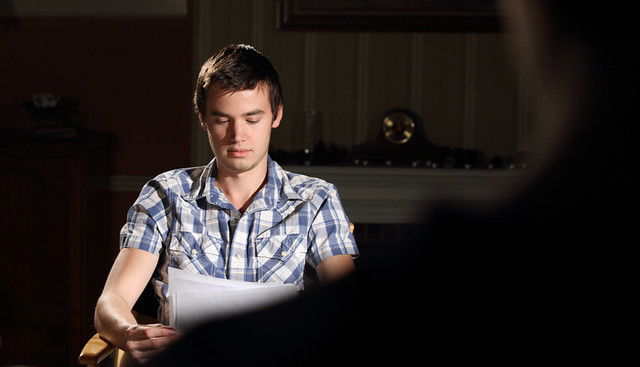 |
| Me, with the camera I used to capture these pictures, the Canon t4i |
My people are filmmakers. We may have different interests and we may have different jobs but we all come together for the same purpose -- to make a film. This particular film is called "Open House" and it is for the Screen Arts 423 class at school, the largest production class that the University of Michigan offers. We started filming on March 15 and finally wrapped April 14 early in the morning, about 2 am. During that month, every weekend (Friday, Saturday, and Sunday) I left campus and joined "my people" on set to make a movie.
 |
| Jackie Vresics, first assistant camera and camera operator, with the Sony F3 |
Although we had attended class together up to that point in the semester, we didn't know each other very well. Needless to say, over the course of that month I got to know everyone on our team, which numbered close to 30. Many of them are in the film department, but some were actors, some did art and design, and even a couple people were in business. We bonded over long shooting hours, pizza for dinner every night, broken equipment, and countless other challenges that we faced. In a way, they became my family. So when this photo essay was assigned, I knew immediately who would be the subject of my photos.
 |
| Rajan Sosale, the assistant director |
 |
| Julie Vis, key grip, sets up a light on set |
For these photos, I chose to do them mostly in portrait, so I could better capture the personalities of everyone on set. I also thought portraits would be good because on set we were dealing with mostly low lighting (since we were filming at night) and I figured portraits would come out better than wider shots. I used the Canon t4i DSLR camera with a 17-55mm IS lens attached to take all these photos, but I had to mess with settings quite a bit.
 |
| Quinn Scillian, actor, hamming it up for the camera |
 |
| Phillip Maxwell, actor |
 |
| Nick Skardarasy, actor, gestures during the filming of a scene |
Again, lighting was fairly dim on the set, so I took the pictures when people were standing near the lights. I tried to avoid flash as much as possible, because it tended to overexpose the whole image. I turned up the ISO a lot, which accounts for some of the grain in these pictures, shot with the aperture wide open, and adjusted the shutter speed as necessary.
 |
| Trend Hibbard, one of our sound recordists and boom operators, with boom |
 |
| Kasey Cox, second assistant camera. She was responsible for the slate. |
One of the biggest issues I ran into when shooting these pictures (I have a lot of outtakes) was focus. Because of the low lighting and the lens I was using, getting the right part of the frame in focus proved to be very difficult. Sometimes I used the auto focus, but when it didn't work quite right I adjusted focus manually.
 |
| Putting up a tension pole to hang lights from is a group effort |
Everyone was so talented, and really wanted to do a good job, and were fun, nice people to be around, so although we worked long hours and things could get a little tense, I looked forward to heading to set every weekend and seeing the whole crew. Everyone has a unique personality, and there are a ton of jokers and comedians on set who loved to mess around, and I wanted these photos to reflect everyone's uniqueness, even though we were all together to accomplish the same goal. The actors, predictably, put themselves on display when the camera turned towards them, but so did some of the other crew.
"My People" are the filmmakers who came to set every weekend, sometimes at 7 or 8pm and prepared to work until dawn, excited and ready to work. We had a lot of fun together, but we also worked really hard and the product of our work, "Open House" is a half-hour short film that will premiere at the Lightworks Film Festival in the Natural Science Auditorium next Friday and Saturday, the 26th and 27th of April.














